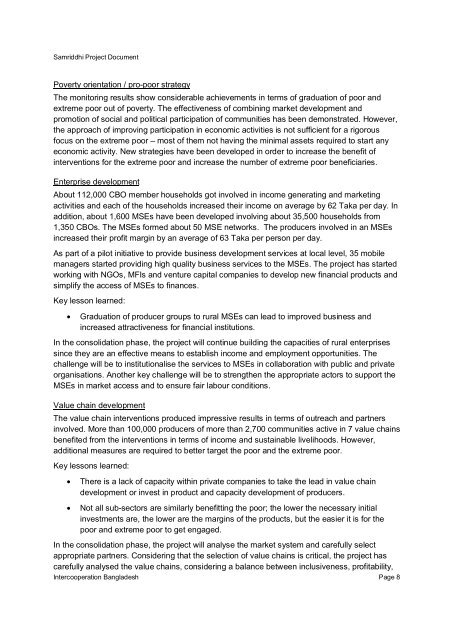Samriddhi
Samriddhi
Samriddhi
Create successful ePaper yourself
Turn your PDF publications into a flip-book with our unique Google optimized e-Paper software.
<strong>Samriddhi</strong> Project Document<br />
Poverty orientation / pro-poor strategy<br />
The monitoring results show considerable achievements in terms of graduation of poor and<br />
extreme poor out of poverty. The effectiveness of combining market development and<br />
promotion of social and political participation of communities has been demonstrated. However,<br />
the approach of improving participation in economic activities is not sufficient for a rigorous<br />
focus on the extreme poor – most of them not having the minimal assets required to start any<br />
economic activity. New strategies have been developed in order to increase the benefit of<br />
interventions for the extreme poor and increase the number of extreme poor beneficiaries.<br />
Enterprise development<br />
About 112,000 CBO member households got involved in income generating and marketing<br />
activities and each of the households increased their income on average by 62 Taka per day. In<br />
addition, about 1,600 MSEs have been developed involving about 35,500 households from<br />
1,350 CBOs. The MSEs formed about 50 MSE networks. The producers involved in an MSEs<br />
increased their profit margin by an average of 63 Taka per person per day.<br />
As part of a pilot initiative to provide business development services at local level, 35 mobile<br />
managers started providing high quality business services to the MSEs. The project has started<br />
working with NGOs, MFIs and venture capital companies to develop new financial products and<br />
simplify the access of MSEs to finances.<br />
Key lesson learned:<br />
• Graduation of producer groups to rural MSEs can lead to improved business and<br />
increased attractiveness for financial institutions.<br />
In the consolidation phase, the project will continue building the capacities of rural enterprises<br />
since they are an effective means to establish income and employment opportunities. The<br />
challenge will be to institutionalise the services to MSEs in collaboration with public and private<br />
organisations. Another key challenge will be to strengthen the appropriate actors to support the<br />
MSEs in market access and to ensure fair labour conditions.<br />
Value chain development<br />
The value chain interventions produced impressive results in terms of outreach and partners<br />
involved. More than 100,000 producers of more than 2,700 communities active in 7 value chains<br />
benefited from the interventions in terms of income and sustainable livelihoods. However,<br />
additional measures are required to better target the poor and the extreme poor.<br />
Key lessons learned:<br />
• There is a lack of capacity within private companies to take the lead in value chain<br />
development or invest in product and capacity development of producers.<br />
• Not all sub-sectors are similarly benefitting the poor; the lower the necessary initial<br />
investments are, the lower are the margins of the products, but the easier it is for the<br />
poor and extreme poor to get engaged.<br />
In the consolidation phase, the project will analyse the market system and carefully select<br />
appropriate partners. Considering that the selection of value chains is critical, the project has<br />
carefully analysed the value chains, considering a balance between inclusiveness, profitability,<br />
Intercooperation Bangladesh Page 8
















